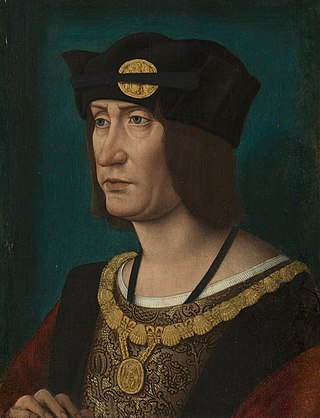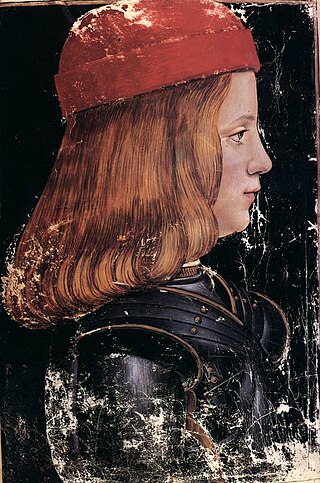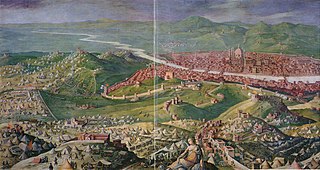
Louis XII, also known as Louis of Orléans, was King of France from 1498 to 1515 and King of Naples from 1501 to 1504. The son of Charles, Duke of Orléans, and Marie of Cleves, he succeeded his second cousin once removed and brother-in-law, Charles VIII, who died childless in 1498.

Maximilian Maria Sforza was a Duke of Milan from the Sforza family, the son of Ludovico Sforza.

The Battle of Pavia, fought on the morning of 24 February 1525, was the decisive engagement of the Italian War of 1521–1526 between the Kingdom of France and the Habsburg Empire of Charles V, Holy Roman Emperor as well as ruler of Spain, Austria, the Low Countries, and the Two Sicilies.

The Duchy of Milan was a state in Northern Italy, created in 1395 by Gian Galeazzo Visconti, then the lord of Milan, and a member of the important Visconti family, which had been ruling the city since 1277.

The War of the League of Cambrai, sometimes known as the War of the Holy League and several other names, was fought from February 1508 to December 1516 as part of the Italian Wars of 1494–1559. The main participants of the war, who fought for its entire duration, were France, the Papal States, and the Republic of Venice; they were joined at various times by nearly every significant power in Western Europe, including Spain, the Holy Roman Empire, England, the Duchy of Milan, the Republic of Florence, the Duchy of Ferrara, and the Swiss.

The Battle of Marignano was the last major engagement of the War of the League of Cambrai and took place on 13–14 September 1515, near the town now called Melegnano, 16 km southeast of Milan. It pitted the French army, composed of the best heavy cavalry and artillery in the world, led by Francis I, newly crowned King of France, against the Old Swiss Confederacy, whose mercenaries until that point were regarded as the best medieval infantry force in Europe. With the French were German landsknechts, bitter rivals of the Swiss for fame and renown in war, and their late arriving Venetian allies.

The War of the League of Cognac (1526–30) was fought between the Habsburg dominions of Charles V—primarily the Holy Roman Empire and Spain—and the League of Cognac, an alliance including the Kingdom of France, Pope Clement VII, the Republic of Venice, the Kingdom of England, the Duchy of Milan, and the Republic of Florence.

The Battle of Novara was a battle of the War of the League of Cambrai fought on 6 June 1513, near Novara, in Northern Italy. A French attacking force was routed by allied Milanese–Swiss troops. As a consequence, France was forced to withdraw entirely from Italy.

Georg von Frundsberg was a German military and Landsknecht leader in the service of the Holy Roman Empire and Imperial House of Habsburg. An early modern proponent of infantry tactics, he established his reputation in active service during the Italian Wars under Emperor Maximilian I and his successor Charles V. Even in his lifetime, he was referred to as "Vater der Landsknechte" and legends about him as the patriarchal figure of the Landsknechte or his incredible physical strength surfaced. He achieved great prestige and fame for his role in the Habsburg victory at Pavia against France and during the war of the League of Cognac.

Gian Giacomo Trivulzio was an Italian aristocrat and condottiero who held several military commands during the Italian Wars.

The Battle of Bicocca or La Bicocca was fought on 27 April 1522, during the Italian War of 1521–26. A combined French and Venetian force under Odet de Foix, Vicomte de Lautrec, was decisively defeated by an Imperial–Spanish and Papal army under the overall command of Prospero Colonna. Lautrec then withdrew from Lombardy, leaving the Duchy of Milan in Imperial hands.

The First Italian War, or Charles VIII's Italian War, was the opening phase of the Italian Wars. The war pitted Charles VIII of France, who had initial Milanese aid, against the Holy Roman Empire, Spain and an alliance of Italian powers led by Pope Alexander VI, known as the League of Venice.

The Italian Wars of 1499–1504 are divided into two connected, but distinct phases: the Second Italian War (1499–1501), sometimes known as Louis XII's Italian War, and the Third Italian War (1502–1504) or War over Naples. The first phase was fought for control of the Duchy of Milan by an alliance of Louis XII of France and the Republic of Venice against Ludovico Sforza, the second between Louis and Ferdinand II of Aragon for possession of the Kingdom of Naples.

Louis II de la Trémoille, also known as La Trimouille, was a French general. He served under three kings: Charles VIII, Louis XII and Francis I. He was killed in combat at the Battle of Pavia.

The Italian War of 1521–1526, sometimes known as the Four Years' War, was a part of the Italian Wars. The war pitted Francis I of France and the Republic of Venice against the Holy Roman Emperor Charles V, Henry VIII of England, and the Papal States. It arose from animosity over the election of Charles as Emperor in 1519–1520 and from Pope Leo X's need to ally with Charles against Martin Luther.

The Italian campaign of 1524–1525 was the final significant action of the Italian War of 1521–1526 launched by the French into Northern Italy. Led by Francis I of France, the French attempted to dislodge the Habsburgs from Italy in an attempt to control Italy for themselves. After the French invaded Lombardy, the campaign would then primarily consist of the French attempt to capture the city of Milan. However, after Francis's defeat at the Siege of Pavia, the French were driven out of Italy and Francis was taken prisoner.

Prospero Colonna (1452–1523), sometimes referred to as Prosper Colonna, was an Italian condottiero who was active during the Italian wars and served France, Spain, the Holy Roman Empire and various Italian states.
The siege of Novara took place in the summer and autumn of 1495 during the Italian War of 1494–1495. While king Charles VIII of France was retreating to the north after facing rebellions in the recently conquered Kingdom of Naples, and managed to escape the destruction of his army at the Battle of Fornovo, his cousin and future king Louis d'Orleans opened a second front by attacking the Duchy of Milan and occupying the city of Novara. In an effort to retrieve it, the Milanese army and their League of Venice allies besieged Novara for three months and fourteen days. Suffering from severe starvation and disease, the French lost about 2000 soldiers before Louis had to surrender and withdraw.

















